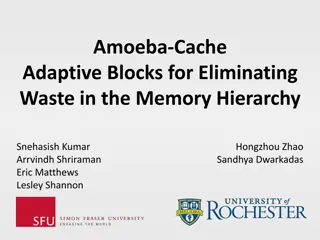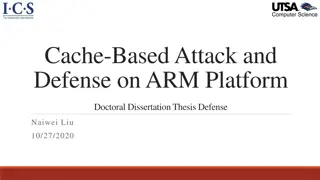Defending Against Cache-Based Side-Channel Attacks
The content discusses strategies to mitigate cache-based side-channel attacks, focusing on the importance of constant-time programming to avoid timing vulnerabilities. It covers topics such as microarchitectural attacks, cache structure, Prime+Probe attack, and the Bernstein attack on AES. Through detailed explanations and examples, the text emphasizes the critical need for secure coding practices and countermeasures to protect sensitive data from exploit.
Download Presentation

Please find below an Image/Link to download the presentation.
The content on the website is provided AS IS for your information and personal use only. It may not be sold, licensed, or shared on other websites without obtaining consent from the author.If you encounter any issues during the download, it is possible that the publisher has removed the file from their server.
You are allowed to download the files provided on this website for personal or commercial use, subject to the condition that they are used lawfully. All files are the property of their respective owners.
The content on the website is provided AS IS for your information and personal use only. It may not be sold, licensed, or shared on other websites without obtaining consent from the author.
E N D
Presentation Transcript
Thwarting cache-based side- channel attacks Yuval Yarom The University of Adelaide and Data61
The binary search needs to be done in constant time to avoid timing issue. But it's fast, so there's no problem. An anonymous reviewer, AsiaCrypt 2016
Outline Introduction to cache attacks Constant-time programming Testing for constant-time
The Microachitecture ISA TLB Microarchitecture Pipeline BPU Instruction Cache Data Cache MMU LLC DRAM Interconnect
Microarchitectural attacks Force contention on microarchitectural components Creating timing variations That are used to expose an intarnal state Which depends on secret data Allowing the attacker to infer said data 5
Cache Structure Stores fixed-size lines Arranged as multiple sets, each consisting of multiple ways. Each memory line maps to a single cache set Can be cached in any of the ways in the set Memory Sets Cache Ways 6
The Prime+Probe attack Choose a cache-sized memory buffer Access all the lines in the buffer, filling the cache Victim executes, evicting some of the buffer lines from the cache Measure the time to access the buffer Accesses to cached lines is faster than to evicted lines Memory Cache C. Percival, "Cache Missing for Fun and Profit", BSDCan, 2005 D. A. Osvik, A. Shamir and E. Tromer, "Cache Attacks and Countermeasures: The Case of AES", CT-RSA 2006 7
Prime+Probe attack on GnuPG 1.4.13 Square Multiply
The Bernstein attack AES tables stored in memory Table access patterns depend on both the key and the plaintext/ciphertext Access time depends on the pattern of previous accesses Attack: Create timing profiles for each key byte Measure timing Match with profile Timing Profile for byte 15 [Ber05] 9 D. J. Bernstein, "Cache-timing attacks on AES",http://cr.yp.to/antiforgerycachetiming-20050414.pdf, 2005
FLUSH+RELOAD Processor FLUSH memory line Wait a bit Measure time to RELOAD line slow-> no access fast-> access Repeat Cache Memory D. Gullasch, E. Bangerter and S. Krenn, Cache Games - Bringing Access-Based Cache Attacks on AES to Practice , IEEE S&P 2011 Y. Yarom and K. Falkner, Flush+Reload: a High Resolution, Low Noise, L3 Cache Side-Channel Attack , USENIX Security 2014 10
Why focus on crypto? Because that s where the keys are Small code base with fairly regular operation Narrow semantic gap between the code and the leak
Mitigation Strategies System Avoid/reduce sharing Insert noise (e.g. noisy timers, random caches) Software Inject noise (e.g. blinding) Constant-time programming
Constant-time programming Execution time does not depend on any secret data Three rules: No instructions with data-dependent execution time No secret-dependent flow control No secret-dependent memory access
Constant-time programming in practice
Checking for constant-time Manual testing is not easy and is error-prone.
Dynamic Analysis ctgrind A patch against valgrind memcheck Dynamically taints secret-dependent data Warns on secret-dependent branches and memory access Dynamic analysis can miss code paths A. G. Langley, ctgrind https://github.com/agl/ctgrind
Source Analysis FlowTracker Uses information flow analysis to identify non- constant-time-accesses Potential mismatch between code and binary B. Rodrigues, F. M. Q. Pereira, D. F. Aranha, Sparse Representation of Implicit Flows with Applications to Side-Channel Detection , CC 2016
Binary Analysis CacheAudit Analyses the amount of leakage from a binary given a cache model The analysis may miss some important cache configurations Not all of the microarchitecture is modeled Cache banks? Branch Prediction? Cache slices? May accept implementations that are not constant-time G. Doychev, B.K pf, L.Mauborgne and J.Reineke, CacheAudit: A Tool for the Static Analysis ofCache Side Channels , TISSEC 18(1) 2005 G. Doychev and B. K pf, Rigorous Analysis of Software Countermeasures against Cache Attacks , aarXiv 1603.02187, 2016
What about instructions with data- dependent time? ISA TLB Pipeline BPU Instruction Cache Data Cache MMU LLC DRAM Interconnect
What about instructions with data- dependent time? We rely on partial and misleading documentation What if? A vendor decide to shortcut additions or multiplications of known zeros? Writes that do not modify the value do not result in a dirty cache line? We need guarantees on CPU behaviour See https://blog.cr.yp.to/20140517-insns.html
Summary Microarchitectural attacks are a threat to the security of cryptographic implementations Constant time programming is our current best defence But we still need: Improved proofs of correctness Better tests for constant-time Vendor guarantees on the hardware























